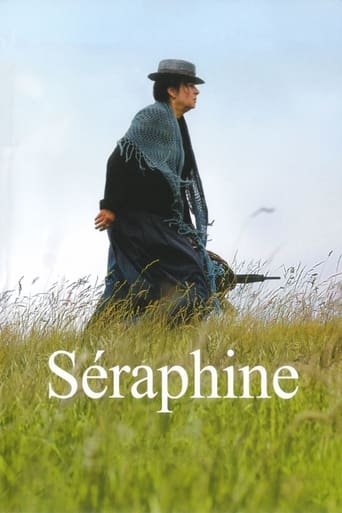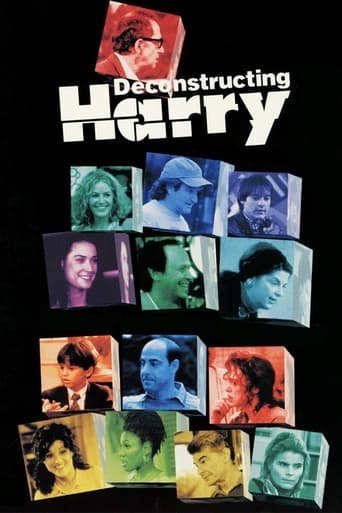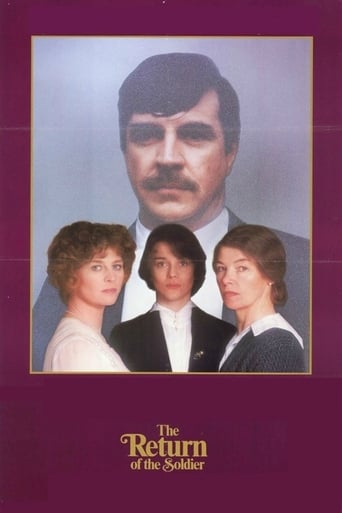


Séraphine
The tragic story of French naïve painter Séraphine Louis aka Séraphine de Senlis (1864-1942), a humble servant who becomes a gifted self-taught painter. Discovered by prominent critic and collector William Uhde, she came to prominence between the wars grouped with other naïve painters like Henri Rouseau only to descend into madness and obscurity with the onset of Great Depression and World War II.
-
- Cast:
- Yolande Moreau , Ulrich Tukur , Anne Bennent , Geneviève Mnich , Nico Rogner , Adélaïde Leroux


Similar titles










Reviews
Pretty good movie overall. First half was nothing special but it got better as it went along.
The film makes a home in your brain and the only cure is to see it again.
This is a small, humorous movie in some ways, but it has a huge heart. What a nice experience.
Exactly the movie you think it is, but not the movie you want it to be.
Séraphine is a French-Belgian production about the housekeeper turned artist of the same name, who first gained fame between the last two World Wars. Creating films about famous artists are difficult since they're inherently not very dramatic. Highlighting the beauty of the artist's creation is one thing but designing a full-fledged drama concerning the artist and his/her interactions with the people they knew, could be problematic.While I would not call the story of Séraphine a gripping tale where you'll find yourself on the edge of your seat, it does manage to hold your interest, despite its languid pace. It's in fact, a very well- crafted biopic, that features some sensational cinematography.The story is rather simple. Séraphine is a devoted Catholic, middle-aged housekeeper who also happens to be a talented painter. She collects some of the ingredients for her paint from unusual sources including wax from candles in her local church, soil from plants and blood from a dead pig. One of the lodgers in a house she services is Uhde, an up and coming art critic and collector from Germany, who recognizes Séraphine's potential, despite disparaging remarks made about her artwork by the local gentry. Uhde even buys a few of Séraphine's paintings but eventually loses all his art possessions when World War I begins and he's forced to flee France, back to Germany.When Uhde returns to France between the wars in 1927, he looks Séraphine up again and notes her skills have improved a hundred fold. Now she's creating large works of art on giant canvasses. For a time, Uhde is able to have Séraphine's artwork shown in well-known galleries and pays her money where she's able to rent her own apartment. The onset of the Depression causes the art market to collapse and Uhde is no longer able to provide Séraphine with financial support. This perhaps precipitates the onset of her mental illness and eventually Séraphine has to be hospitalized. Her treatment at the hospital is not good and she falls deeper into psychosis. Uhde finally is able to sell some of Séraphine's paintings by around 1935 and uses the proceeds to make her more comfortable at the hospital. As noted above, 'Séraphine' is a slow-moving affair. Nonetheless, the method by which she creates her paintings, her religious zeal and her unusual relationship with Uhde, is enough for us to remain interested throughout. It's revealed at the end of the film that Séraphine never left the mental hospital and died in 1942. Uhde who was both gay and Jewish, was forced to hide in the South of France while the Nazis occupied the country. He died in 1947, two years after the end of World War II.
Most artists' lives are marked with excessive obsessions about what they are trying to accomplish. Some go to extremes as they are consumed with a passion about their work that eventually serve to render them into lunatics because of the demands they impose on themselves and on the work they are trying to create. Such is the case with Seraphine Louis, a poor woman from rural Senlis, in the Oise department of France.The life of Seraphine is at the center of a film that tries to understand a complex life that only brought her sadness and heartaches, and conspired to land her in an asylum for the mentally insane. Her life was marked by poverty. Seraphine was a shepherd, who loved being in the wide open spaces of the rural community in which she lived. Whenever she felt sad, she would go out and touch a tree.When we meet her, she is working as a maid, scrubbing floors and cleaning for a family earning a meager salary. Wilhem Uhde, a German critic and gallery owner, arrives in Senlis for a stay. Seraphine is asked to do the cleaning for the Uhde and his sister. Secretly, Seraphine is seen going to church to steal the contents of the votive candles, as well as going to the butcher where she takes blood in small vials for an unknown reason. Seraphine was involved with the nuns of a local convent, visiting them often. We see her occasionally singing to the Madonna icon in her small room.Nothing prepares us for what she really loves to do. One day, she brings a small painting to her employer, a nasty old woman, who thinks the apples in the picture look hideous. Uhde, accepting a invitation from his landlady, is amazed by the intensity the artist of the painting. He is even more surprised when he is told his own maid has done it. Little prepares Uhde for the treasures he finds in Seraphine's room. Unfortunately, WWI is about to start and as a German, he must leave his beloved France for a safe heaven.Years went by and Wilhem and his sister return to Chantilly, not far from Senlis. Going to an exhibit, he finds out Seraphine is still alive and producing her paintings, only now, made in larger canvas instead of the primitive wooden frames she used. Uhde becomes her champion. With a bit of the new recognition, Seraphine begins to go for the things she never had. She begins to spend more than she can afford, trying to imitate the rich people whose houses she cleaned in the past. With her obsession she keeps getting more and more irrational, something that will develop into some kind of madness she cannot control. Wilhem realizes Seraphine is beyond help and he decides to institutionalize her in a facility where she will never get better.The film directed by Martin Provost impresses us for its beauty as well as for a wasted life that had such unrealized possibilities. The director wrote the screenplay with Marc Abdelnour. The film follows an extraordinary woman who created a wonderful body of work, much admired, after she was no longer around. Such is the life of many creative talents that were never recognized for their art. The only thing that is not made clear in the film is the earlier part of Seraphine's life since we only meet her after she is a grown woman.The work of Yolande Moreau is magnificent. She convinces she is none other than the poor woman eking a life. Ms. Moreau has been acting for quite some time, but never was a role so perfect for her as this Seraphine. Ulrich Tukur is equally excellent as Wilhem Uhde, a man who lived a personal tragedy, but who was a genius as far as spotting artists that needed to be known. The cinematography by Laurent Brunet takes us to that part of rural France with the wonderful views of the small town and countryside. The musical score Michael Galasso created for the film works well in the film. Martin Provost had a great vision and he painted a large canvas taking the viewer along to examine the beauty thus created.
Seraphine Louis (1864-1942), who used the name Seraphine de Senlis (for the town where she worked), was French cleaning-woman who heared voices of angels and painted vivid flower arrangements. She was eventually closed into mental hospital. Unconventional and humanistic, Seraphine is a film which treats this obese middle-aged woman - who looked like a sweet old granny in the pictures I have seen - as a beautiful human being, unpolluted crazy visionary. Unfortunately film itself is academic with drab and ugly colours - so natural, so normal, so realistic. Subject was interesting and rich, film was well-meaning but poor.
A frumpy cleaning woman well into middle age is discovered by an art critic to be a painter with talent comparable to Vincent Van Gogh. Her story is told in the riveting Seraphine, directed by Martin Provost and winner of seven Césars, the French version of the Oscars, including a best actress award for Yolande Moreau. With a screenplay by Martin Provost and Marc Abdelnour, the film is set in the village of Senlis outside of Paris where Séraphine Louis (Yolande Moreau) lives alone and must take odd jobs just to pay for her painting supplies. Séraphine is a visionary, a devout Catholic who believes she is guided by a guardian angel and her exotic paintings of flowers and plants describe her feelings of closeness to spirit.Treated with disdain by her condescending employer, her life takes on new meaning when a tenant, German art critic Wilhelm Uhde (Ulrich Tukur) hires Séraphine to clean for him and accidentally discovers one of her paintings that her boss had tossed aside. A champion of modern "primitvist" artists who is credited with early recognition of Picasso and Rousseau, Uhde is portrayed by Tukur as a quiet, unassuming man who lives with his sister and a gay lover. He recognizes Séraphine's talent but never shows much enthusiasm, preferring to keep their relationship on a very business-like basis.Impressed by Seraphine's passionate art, Uhde offers to become her patron but, feeling estranged in France, must soon leave the country to return to Germany as the First World War begins. Although Séraphine continues to paint, she has no connection with Uhde until the latter part of the 1920s when he provides her with the means to quit her job and paint full time. Unfortunately, her grip on reality falters and she is soon hospitalized after indulging in spending sprees on a wedding dress and purchase of a large mansion. One of the saddest scenes in the film is that of Séraphine dressed in a full wedding gown, going door to door giving her away her possessions.Provost in Séraphine captures the artist's mystical nature and her close bond with nature that shows up in her works, which are still exhibited in many of the world's museums. She is shown hugging trees, climbing them, and standing as a tiny speck beneath a towering shade tree. One scene shows her standing nude in water up to her chest in a nearby river. Provost takes a minimalist approach and the film does not contain much dialogue. The story is told by the silences and facial expressions and the music by Michael Galasso adds richness to the experience. Fully capturing the eternal mystery of the creative process, Séraphine itself is a work of art.
